By SUE COLETTA
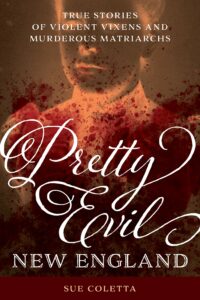 An interesting discussion arose while working on copy edits for Pretty Evil New England. The conversation dealt with using block quotes—when, where, why, and how I used them in the (nonfiction) manuscript.
An interesting discussion arose while working on copy edits for Pretty Evil New England. The conversation dealt with using block quotes—when, where, why, and how I used them in the (nonfiction) manuscript.
If at all possible, I tend to use quoted material as dialogue to create scenes. But there were times where I chose to block quote the text instead. For example, if the quote was mainly backstory and not part of the actual scene but still important for the reader to understand, then I used block quotes. You’ll see what I mean in one of the examples below.
Block quotes can’t be avoided at times. They can even enhance the scene, thereby adding to the overall reading experience. In fiction, two examples of where to use block quotes would be a diary entry or a note/letter/message. Please excuse my using one of my thrillers; it’s easier than searching through a gazillion books on my Kindle.
In Silent Mayhem, the antagonist and hero communicate through an Onion site (untraceable) on the deep web. Because these messages are neither dialogue, nor narrative, using block quotes set them apart.
Example:
Dearest Cautious Cat,
If we shut our eyes to dangers beyond our comprehension, we become powerless to fight. My offer still stands. Should you choose not to accept it, remember this . . .
When it’s your time to die, be not like those whose hearts are filled with the fear of death, so that when their time comes, they weep and pray for a little more time to live their lives over again in a different way. Sing your death song and die like a hero going home.
Hugs & kisses,
Mr. M
Block quotes also break up the text and enhance white space. We’ve discussed white space many times on TKZ. For more on why white space is a good thing, check out this post or this one.
BLOCK QUOTES IN WORD
To include block quotes in Word, highlight the text and right click. This screen will pop up…
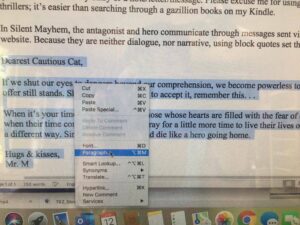 Choose “paragraph” and this screen will pop up…
Choose “paragraph” and this screen will pop up…
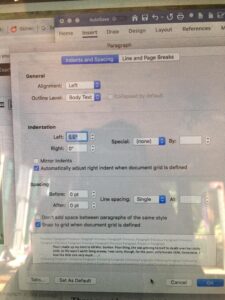
Reset your left margin to .5 and click OK. Leave the right margin alone.
Quick note about margins.
A good rule of thumb for block quotes is to not indent the first paragraph. If your passage contains more than one paragraph, check with the publisher. Most supply a style guide. For instance, my thriller publisher keeps all paragraphs justified. My true crime publisher prefers that the first paragraph be justified and subsequent paragraphs be indented.
To do that, the easiest thing is to click “Special” then “first line” (as indicated in pic below) and set it to .25. Then simply backspace to erase the indent on the first paragraph.
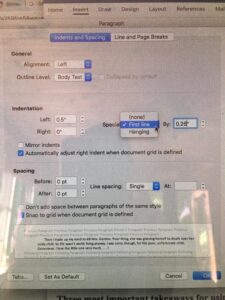
If you’re self-publishing, then obviously it’s your call on whether to indent or not to indent subsequent paragraphs.
BLOGGING BLOCK QUOTE
Bloggers who include passages from a resource, whether that be a book or wording from a reputable source, use block quotes to signal the reader that the passage is a direct quote (most commonly, all justified margins). You could style the post in Word, then copy/paste, but sometimes the style doesn’t paste over. Simple fix. Highlight the text and click this symbol…
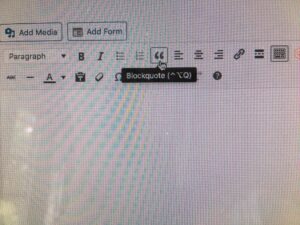 And that’s it. Easy peasy, right?
And that’s it. Easy peasy, right?
ELLIPSIS
An ellipsis consists of either three or four dots. A single dot is called an ellipsis point. Some writers may find using ellipses a little tricky, but once you know the definitions of where, why, and how to use them, determining the right ellipses is fairly straightforward.
According to the Chicago Manual of Style, never use ellipses at the beginning or end of a block quote. CMOS also recommends using equal spacing between dots. Some style guides say to use three equally spaced periods rather than creating an ellipsis in Word, which you can do by pressing CTRL + ALT + Period. Always go by the style guide furnished by the publisher (or editor, if self-publishing).
WHERE AND WHY TO USE ELLIPSES
There are many reasons why you might want to use an ellipsis. An ellipsis can indicate omitted words within the middle of a quote, or faltering dialogue, or an unfinished sentence or thought where the speaker’s words trail off.
For faltering dialogue, you have two choices, depending on your style guide.
Style #1: Equally spaced dots with one space before and after ellipsis.
Style #2: Unspaced dots with one space before and after ellipsis.
Example #1 (uses three periods): “I . . . I . . . would never break the law.”
Example #2 (uses ellipsis created with Word shortcut): “I … I … would never break the law.”
For words that trail off, insert punctuation at end of ellipses. If the dialogue continues to another sentence, leave a space.
Example #1: “Why would he . . .? I mean, I can’t believe he got caught with that bimbo.”
Alternate style (Word shortcut): “Why would he …? I mean, I can’t believe he got caught with that bimbo.”
Example #2: “My weight? I’m about one hundred and . . . So, how ’bout them Bears. Did you watch the game?”
Alternate style (Word shortcut): “My weight? I’m about one hundred and … So, how ’bout them Bears. Did you watch the game?”
THREE DOTS VERSE FOUR
Here’s where some writers may find ellipses a little tricky.
Sometimes we need to omit words from the end of one sentence but still continue the quoted passage. This type of ellipsis is called a terminal ellipsis. In this instance, the CMOS recommends using four dots, or periods. The fourth dot indicates the period at the end of the sentence that we haven’t quoted in its entirety. By including that fourth dot it lets the reader know that the quotation borrows from more than one sentence of the original text.
Example from Pretty Evil New England:
Then I made up my mind to kill Mrs. Gordon. Poor thing, she was grieving herself to death over her sickly child. So life wasn’t worth living anyway. I was sorry, though, for the poor, unfortunate child, Genevieve. I love the little one very much. . . . I thought with Mrs. Gordon out of the way I could be a mother to her child and get [her husband] Harry Gordon to marry me.
Notice how I didn’t omit any necessary words? That’s key. We have a responsibility to other writers—in this case, the female serial killer—to not mislead the reader by leaving out words that change the meaning of the quote.
Three most important takeaways for ellipses in dialogue.
- Avoid ellipses overload—too many can diminish their impact.
- Reserve ellipses for middle and end of dialogue. If the character fumbles around to spit out their first word, use a body cue or other description instead.
- Maintain consistent ellipses spacing throughout the manuscript.
Now, like most things in writing, there are exceptions to these rules. Always follow the publisher or editor’s recommendations. If you don’t have any recommendations to follow, feel free to use this post as a guide.
For discussion: Do you use block quotes in your writing? If so, why did you choose to do that? Care to share one of the exceptions to any of these guidelines?

Pingback: When, Where, Why, and How To Use Block Quotes and Ellipses - Dooiz
I love ellipses and em dashes. For first paragraphs of chapters and scenes, I have a 1st paragraph style set up in word. Fewer steps. If I want something set apart, I just use the “increase indent” option for that section. For ellipses, I just type three dots and have Word set to make them ‘official’ ellipses.
AS for whether it’s 3 or 4 dots? That’s where I pay an editor in case I get it wrong.
Good idea, Terry! Some editors ask for ellipses created in Word and some don’t. Hence why style guides are so helpful.
Sue, really helpful. Thanks. I’ve used block quote in WP but not in Word so am glad to learn how to do it correctly.
Question about ellipses: Sometimes in dialogue, a character trails off in a sentence and a second character finishes the sentence. I’ve used ellipsis to begin the finisher’s sentence. Is this correct?
“Maybe she only meant to scare him, but…”
“…the gun went off accidentally.”
Same question about spouses who finish each other’s sentences.
Chicago Manual of Style says it’s not correct. You’re better of using an em dash to indicate the wife interrupted her husband or vice versa.
Great information, Sue…(stumbling around to finish my sentence…) 🙂
Question: I have a MS I’m working on, kind of about 3rd or 4th down on my priority list, where the story is about a little girl who finds her grandmother’s journal. (First Page Critiqued on TKZ. Title: The God Glasses)
My construction idea is: After she finds the journal, to open each subsequent chapter with an excerpt from the diary-an excerpt which would enhance (or guide) her experience in that chapter. On the page, it would be the first thing the reader sees, above the chapter heading.
Now I’m thinking of using the block quote technique you describe and incorporating it more into the chapter, under the chapter heading, with the little girl (Ella) actually reading it. The former method would, I think, take the journal entries outside the story-something I don’t want to do. (Hope this is clear enough…it’s early.)
What say you?
Since it’s a diary entry, I would use block quotes to set it apart. If you plan to open with the diary, include a line or two to set the scene. Example: So-and-so leafed through the diary to where she left off the day before. Then block quote the entry.
Thanks! I like that. 🙂
For short quotes, I’ve seen publishers center and italicize it. That both ties it to the centered chapter header and separates it from the standard text.
Exactly, Marilynn.
Yeah, I’ve got my CMoS handy for elipses use. Good summary.
For blockquotes, in my last time travel adventure, I’ve got a character reading a 40,000-year-old journal entry (don’t ask ;-). It’s perfect blockquote territory. Very easy to do in InDesign (for print), and relatively easy for ebook with HTML/CSS.
BTW, if you want to highlight something on a blog or website using a blockquote, just use the HTML tag—not sure it’s going to show up here but I’ll try:
Hey, it worked! Here’s the HTML code:
1. OPENING TAG: left carrot, the word blockquote, right carrot.
2. the words you want to blockquote
3. CLOSING TAG: left carrot, slash, the word blockquote, right carrot.
Clear as mud?
Ooh, thanks, Harald! I had no idea how to do it with HTML.
Yes, I used block quotes in my upcoming novel to indicate Twitter posts. Also used ellipses early on when my heroine is meeting her idol for the first time and is tongue-tied.
Block quotes are perfect for Twitter posts, Maggie. Hope you sell truckloads!
Nicely done article, Sue.
Publisher style books are always a must after you sell the book/article. And, frankly, some are pretty dang weird. (And, boy, do I have some horror stories.)
I use Apple Pages, and the simplest methods seem to translate best to Word, EPUB, or my blog site. Using the ruler and slide to block text, for example.
Thanks, Marilynn. I’ve never used Apple Pages. Do you like it better than Word?
I’ve been a Mac person since the early Eighties so I’ve only used their word processing programs. Plus, Pages is free, and Word is expensive. I’ve rarely had problems dealing with editors, galleys, etc.
Huh. I had no idea. Perhaps I should check out Apple Pages. Thank you!
Much needed reference. Thanks for the examples and clarity.
My pleasure, Lori. It was a fun post to write. 🙂
Yes, I use block quotes, but have a question on your instructions. You mention indenting the left margin, but say to leave the right margin alone. However, in your examples, you’ve also moved the right margin in.
Also, on the terminal ellipsis. I’ve never seen this in the wild (meaning in a published book I’m reading) – “Why would he …?” I always see it without the ? or . I wonder if that’s a style thing depending on the publisher?
Actually, I didn’t touch the right margin, Jeanne. See how it’s jagged? If I were to justify it, it would be straight.
Hmm, I’m not sure how to answer your ellipses question. Perhaps the punctuation slipped by you while reading? All the publishers I’ve worked with use punctuation after the ellipsis, whether that be quotation marks or question mark, etc.
Just realized what you meant. Word will automatically move in the right margin without us touching it.
I use both the block quotes and ellipses for the reasons others have stated. Block quotes are great for dreams and visions in my paranormal thrillers.
Great post! Really explains the proper use of each, especially with the examples.
Dreams and visions are a great way to use block quotes, Cecilia. Thanks for the addition!
Oh this is good advice, Sue! I use a form of block quotes for dream sequences, but had no idea there was a formatting shortcut!
Thank you so much for all of the examples and especially the photos! Putting the advice to use in the manuscript is always the hardest part for me. Sometimes it’s a matter of having a slightly different version of the program, but it’s also knowing exactly what tab in which to start!
I also did not realize there was a difference in ellipses. Seems I’ve gotten away with some rogue formatting in the past!
I’m sharing this post to my writer’s blog so that I’ll have a handy reference when I need it.
Awesome! So glad you found the post useful, Cyn. Happy writing!
Sorry for showing up late in the day, Sue. I’ll throw my gas in the fire while the coals still glow and there’s a ‘smore to roast.
Three years ago, I had no idea what a block quote was and I thought the CMOS was a pay-to-view internet thing you did alone with the drapes drawn and no one watching. That changed when I went into indie manuscript formatting and commercial web copy writing.
My experience is writers should simply write in a Word doc.x and get the story done before edits. Get the thing drafted and then self-edit for stuff you like – commas, ellipses, em-dashes, and that confusing block quote. Once you’ve done the best you can, then pay someone who really knows commas, the CMOS, and all that stuff to clean it up.
I’m talking from an Indie perspective – nobody took a TP chance on me – but I’ve done all right going solo. What I want to pass on to Indie people is that you can get really screwed up in your Word formatting if you don’t do the basics right. One is paragraph indents and I suspect block quotes as well (I never use them in either manuscript of WordPress posts) as well as all the other temptations like headings and html highlights.
Takeaway (For Self Publishers) – Draft in Word.docx and keep it simple. You still have to conform to the CMOS – that’s non-negotiable – but your digital daft will still work with the digital conversions – Mobi, EPub, PDF, and you can always change the small things like block quotes – whatever they are 🙂
Three years ago, I had no idea what a block quote was and I thought the CMOS was a pay-to-view internet thing you did alone with the drapes drawn and no one watching.
Hahahahahaha! Thanks for weighing in, Garry. 🙂
Better late than never, Sue, but thanks SO much for this, particularly for the example. They’re very helpful. I just clipped it to Evernote, something I rarely do.
My pleasure, Joe! I’m so glad you found the post useful. 🙂
Pingback: Top Picks Thursday! For Writers & Readers 06-18-2020 | The Author Chronicles